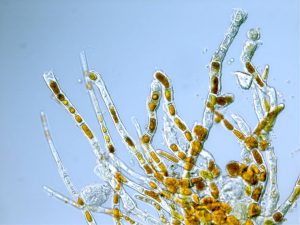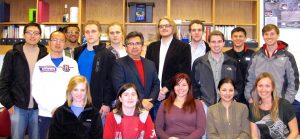
TUSCALOOSA, Ala. — They arrive here by the hundreds. From across Asia, Africa, Europe and South America, they arrive. Sometimes they show up large, dried and mounted on display paper. Other times they are microscopic. Still other times, it’s only a liquid drop – containing a speck of their DNA – at the bottom of a culture tube.
They are algae samples. And they arrive at the request, or, at least with the interest, of Dr. Juan Lopez-Bautista, an associate professor of biological sciences at The University of Alabama. Lopez is the principal investigator in a large National Science Foundation project designed to discover and describe various types of green algae.
Researchers hope to develop a comprehensive understanding of these organisms, including how scientists believe they fit into the world’s evolutionary ladder.
Lopez has built a career studying these organisms that are not classified as plants, although plant-like in appearance. Algae are members of the Protista kingdom, and seaweeds are one type.
The UA scientist is past president of the Phycological Society of America – a group dedicated to the study of algae, and he’s traveled, in recent months, to Florida, South Carolina and even Greece and China to give talks on algae.
The $2.76 million research project, which continues through at least August 2015, also supports the training of post-doctoral researchers, graduate students and undergraduates at UA and four other institutions, nationwide. UA’s share of the funding exceeds $600,000 and comes on the heels of a similar NSF Tree of Life project Lopez led on red algae.
Federal documentation permits Lopez to import the samples from around the world.
The diversity within Lopez’s lab mates, which includes 10 undergraduate student researchers, seemingly rivals the diversity of the samples’ origins. Two students are from Birmingham, two are from Russia and another is from South Korea. Two post-doctoral researchers hail from China and Spain, respectively, and a doctoral student is from Venezuela, said Lopez, a native of Mexico.
“We are creating specialists,” Lopez said. “These students will be the world’s algal specialists in their chosen areas.”

For example, one of the Birmingham students focuses on sea lettuces along Alabama’s coast and elsewhere in the Gulf of Mexico.
The UA professor spoke of the economic importance of algae – they’re found in many food products and used in various household items including clothing and cosmetics – their importance in the food web, and also the dangers of ignoring them.
“You may think most of this work is purely taxonomical and doesn’t have too much application, but many algae that are non-native to the United States have been found around here,” Lopez said. “Algae naturally distributed in Japan and China has been found here in Mobile Bay, growing very abundantly.”
These non-native species do not have natural enemies, such as pests, here to help in their control, Lopez said.
“They are free to grow and can displace many native species. And this can be very dangerous because all these native species are the ones that are feeding the fisheries in the region.” The non-native species’ introduction appears recent and not yet extensive enough to cause alarm, but should be monitored, Lopez said.
There are at least 14,000 described species of green algae worldwide, and, in this project, scientists have selected some 500, representative of the major groups, for closest study, Lopez said.
The UA scientists extract the DNA from the received samples to amplify the genes in which they are most interested and then sequence those genes. More recently Lopez has sequenced whole algal genomes. Results from the UA laboratory are combined with results from the other four institutions involved in the project and fed daily into a secure web site.
“While we are sleeping, the software is analyzing all the new information that has been uploaded that day, and, the next morning, it puts out the new results,” Lopez said. “We always get fresh, new information every day.”
The end result shows researchers which algae are most closely related. Through meetings and publications, this information will be made available to scientists, and the general public, around the globe.
The department of biological sciences is part of UA’s College of Arts and Sciences, the University’s largest division and the largest liberal arts college in the state. Students from the College have won numerous national awards including Rhodes Scholarships, Goldwater Scholarships and memberships on the USA Today Academic All American Team.
Contact
Chris Bryant, UA media relations, 205/348-8323, cbryant@ur.ua.edu
Source
Dr. Juan Lopez-Bautista, 205/348-1791, jlopez@ua.edu